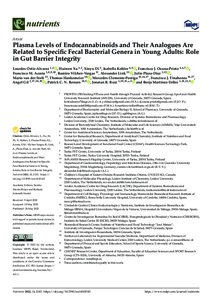Plasma Levels of Endocannabinoids and Their Analogues Are Related to Specific Fecal Bacterial Genera in Young Adults: Role in Gut Barrier Integrity
van der Stelt Mario; Osuna-Prieto Francisco J.; Hankemeier Thomas; Ruiz Jonatan R.; Xu Huiwen; Clemente-Postigo Mercedes; Martinez-Tellez Borja; Acosta Francisco M.; Gil Angel; Link Alexander; Kohler Isabelle; Ortiz-Alvarez Lourdes; Rensen Patrick C. N.; Di Xinyu; Vilchez-Vargas Ramiro; Plaza-Díaz Julio; Tinahones Francisco J.
https://urn.fi/URN:NBN:fi-fe2022081154564
Tiivistelmä
Objective: To investigate the association of plasma levels of endocannabinoids with fecal microbiota.
Methods: Plasma levels of endocannabinoids, anandamide (AEA) and 2-arachidonoylglycerol (2-AG), as well as their eleven analogues, and arachidonic acid (AA), were measured using liquid chromatography-tandem mass spectrometry in 92 young adults. DNA extracted from stool samples was analyzed using 16S rRNA gene sequencing. Lipopolysaccharide levels were measured in plasma samples.
Results: Plasma levels of endocannabinoids and their analogues were not related to beta or alpha diversity indexes. Plasma levels of AEA and related N-acylethanolamines correlated positively with the relative abundance of Faecalibacterium genus (all rho >= 0.26, p <= 0.012) and Akkermansia genus (all rho >= 0.22, p <= 0.036), and negatively with the relative abundance of Bilophila genus (all rho <= -0.23, p <= 0.031). Moreover, plasma levels of 2-AG and other acylglycerols correlated positively with the relative abundance of Parasutterella (all rho >= 0.24, p <= 0.020) and Odoribacter genera (all rho >= 0.27, p <= 0.011), and negatively with the relative abundance of Prevotella genus (all rho <= -0.24, p <= 0.023). In participants with high lipopolysaccharide values, the plasma levels of AEA and related N-acylethanolamines, as well as AA and 2-AG, were negatively correlated with plasma levels of lipopolysaccharide (all rho <= -0.24, p <= 0.020).
Conclusion: Plasma levels of endocannabinoids and their analogues are correlated to specific fecal bacterial genera involved in maintaining gut barrier integrity in young adults. This suggests that plasma levels of endocannabinoids and their analogues may play a role in the gut barrier integrity in young adults.
Kokoelmat
- Rinnakkaistallenteet [19204]
